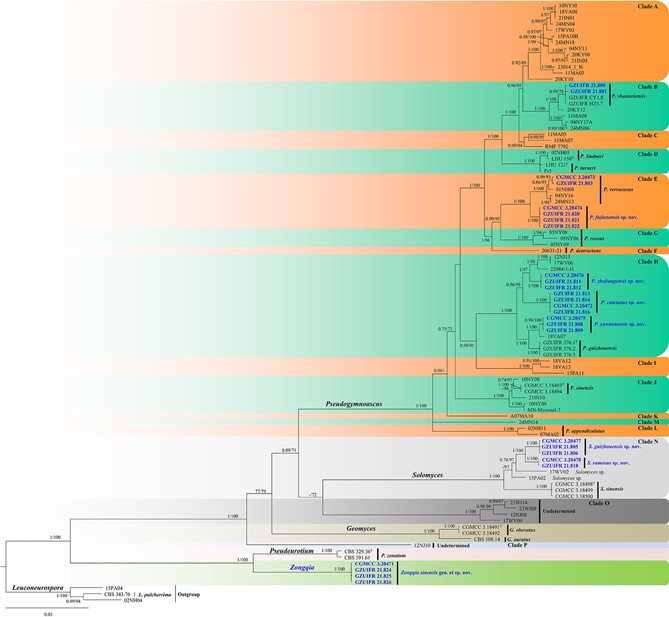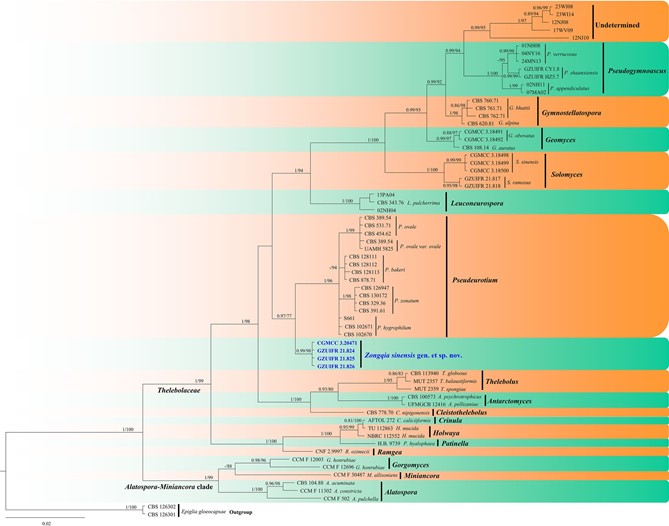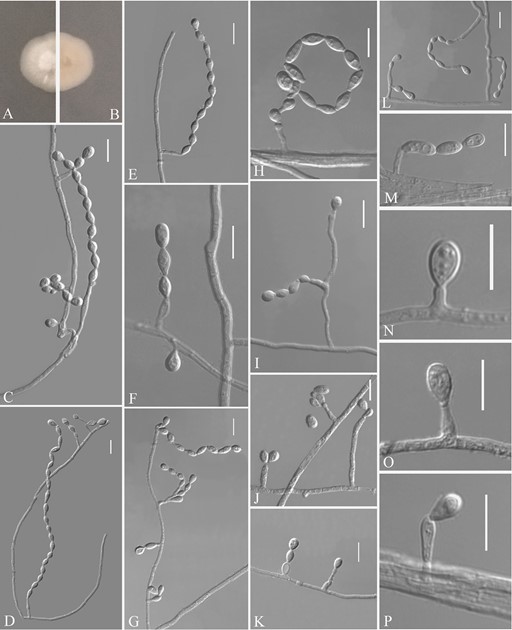Zongqia sinensis Zhang and Han, sp. nov. (Fig. 10).
MycoBank number: MB 840448; Index Fungorum number: IF 840448; Facesoffungi number: FoF14383;
Etymology: named after China where the species is distributed. Diagnosis: the main diagnostic criteria of the species Zongqia sinensis are presence of chains of conidia, conidiophores degenerated into conidiophore cells, clavate conidiophores cells.
Type: China, Guizhou Province, Guiyang, The Affiliated Hospital of Guizhou Medical University, 26.594218N, 106.713166E, isolated from green belt soil, 13 September 2019, Z.Y. Zhang. (Holotype HMAS 350325, stored in a metabolically inactive state; ex-holotype culture CGMCC 3.20471 = GZUIFR 21.823, ibid., GZUIFR 21.824.) GenBank: MZ444088, MZ444089 (ITS); MZ444115, MZ444116 (LSU); MZ490770, MZ490771 (MCM7); MZ488553, MZ488554 (RPB2).
Description. Sexual morph: not observed. Asexual morph: colonies grow slowly on PDA, reaching 11 to 13 mm diameter after 14 days at 25°C, suborbicular, white, floccose, margins regular; reverse white, no growth at 37°C. Hyphae hyaline, branched, septate, smooth, 1.5 to 3.5 mm wide. Conidiophores not observed but degenerated into conidiophore cells. Conidiophore cells hyaline, cylindrical, clavate, arising directly from the aerial hyphae, smooth-walled, solitary. Conidia aseptate, smooth-walled, one-celled, solitary, obovate to sub-obovoid, 5 to 9 by 3 to 5 mm (n = 50); or 2 to 20 in chains, obovate, sub-globose, fusiform and obtuse at apex and base, sometimes cylindrical, clavate, 3.5 to 8.5 (to 12) by 2.5 to 4.5 mm (n = 50). Chlamydospores not observed.
Substrate: soil.
Distribution: Guiyang City, Guizhou Province, China.
Material examined: China, Guizhou Province, Guiyang, Guizhou University, 26.444504N, 106.669296E, isolated from green belt soil, 13 September 2019, Z.Y. Zhang, GZUIFR 21.825. GenBank: MZ444090 (ITS); MZ444117 (LSU); MZ490772 (MCM7); MZ488555 (RPB2). Guizhou Province, Guiyang, Qianlingshan Park, 26.592019N, 106.695434E, isolated from green belt soil, 13 September 2019, Z.Y. Zhang, GZUIFR 21.826.
GenBank: MZ444091 (ITS); MZ444118 (LSU); MZ490773 (MCM7); MZ488556 (RPB2).
Notes. Based on multilocus phylogenetic analyses (Fig. 1 and 2) and similar morphological characteristics, the four strains are regarded as the same species, which cluster together very well and form a single clade separated from other species of Thelebolales. Morphologically, Zongqia sinensis is the only species that produces the conidia chains in this order. Therefore, based on both morphological and phylogenetic evidence, Z. sinensis is proposed as a novel species as a type of Zongqia.

FIG 1 Bayesian inference strict consensus tree illustrating the phylogeny of new taxa and related species in Thelebolales based on a five-loci (ITS, LSU,
MCM7, RPB2, EF1A) concatenated data set. Branches are labeled with Bayesian posterior probabilities of .0.70 and maximum likelihood bootstrap values of
.70%. The new taxa and strains are in bold and blue. Clade names follow previous studies (21, 24).

FIG 2 Bayesian inference strict consensus tree illustrating the phylogeny of genera in Thelebolales based on a two-loci (ITS and LSU) concatenated data set. Branches are labeled with Bayesian posterior probabilities of .0.70 and maximum likelihood bootstrap values of .70%. The new taxa and strains are in bold and blue.

FIG 10 Zongqia sinensis (from ex-holotype CGMCC 3.20471). (A, B) Upper and reverse views of culture on PDA 14 days after inoculation; (C to E, H, I, L, M) conidia chains; (F) conidia borne on hyphae; (G) differentiation of conidiophore cells; (J) two conidia on the apex of conidiophore cells; (K) degenerated conidiophores; (N to P) solitary conidia. Scale bars (C to P), 10 μm.
